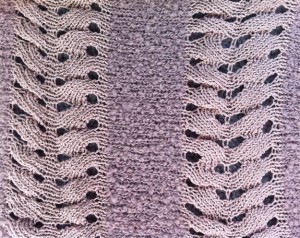Present software makes automating textured designs in these families easier to plan and execute.
This method is limited to single colors being used at any one time and does not allow for additional patterning through fair isle or end needle selection.
Slip stitch in both directions results in black cells being knit sequentially, and the limit in width for the total design is limited to the width of the knitting machine and how the program is read and implemented.
End needle selection is canceled.
All needles in work need to be cleared with each carriage pass.
My electronic km samples are now knit on a 930, which automatically mirrors any downloaded repeats, an advantage for lettering, but not for many other situations. These designs require mirroring when using any machine or software that does so if the holding is to begin with the knit carriage on the right. 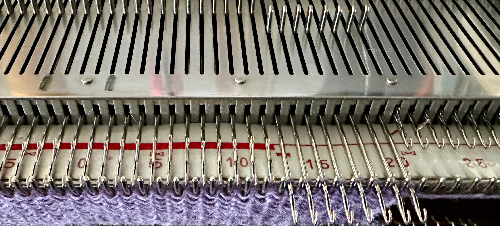 The direction of movement for the knit carriage is illustrated by arrows in the charts, which serve as guides in planning sequences.
The direction of movement for the knit carriage is illustrated by arrows in the charts, which serve as guides in planning sequences.
The original charts were executed using Mac Numbers, the table was converted and scaled to size using Gimp as described in other posts, downloaded using img2track, and mirrored horizontally before test knitting on the 930.
Both swatches are 40 stitches wide, planned in blocks 8 stitches in width and height, the first repeat 40X178 pixels 
The first test: the knit carriage is set to slip in both directions. A wool yarn was used, retaining spring-back for more of a 3D texture. The design can be interrupted with all knit rows breaking up the shapes at varied intervals, with added colors if preferred. 
 The second repeat, 40X 226 pixels.
The second repeat, 40X 226 pixels.  A PDF for larger views of both files pdf
A PDF for larger views of both files pdf
A quick test in a 2/18 wool produced a soft, loose, drapey knit.  The same swatch was photographed 48 hours later, in a relaxed state.
The same swatch was photographed 48 hours later, in a relaxed state.  A 2/10 wool knit on the same number of stitches produced a firmer and more clearly 3D effect which remains unaltered with time.
A 2/10 wool knit on the same number of stitches produced a firmer and more clearly 3D effect which remains unaltered with time.
Hems and a knit stripe were tested as a way of breaking up the shapes 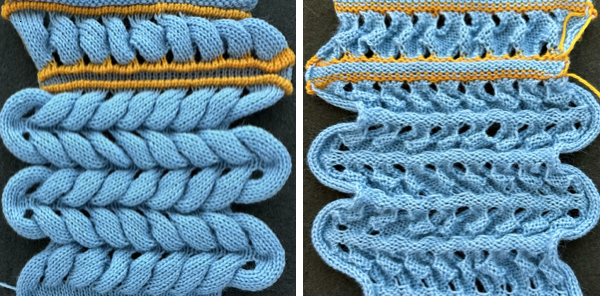 Possibilities with hand selection of needles: some samples from Adding fair isle patterning to short row patterns creating eyelets.
Possibilities with hand selection of needles: some samples from Adding fair isle patterning to short row patterns creating eyelets.
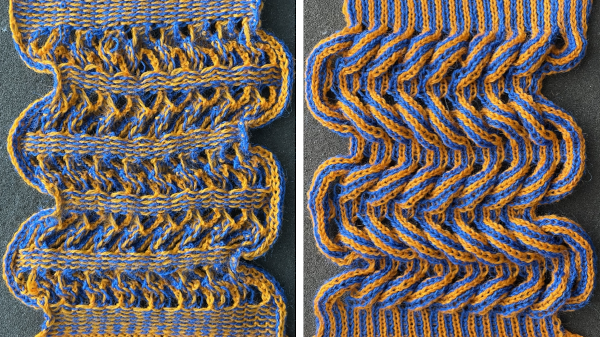


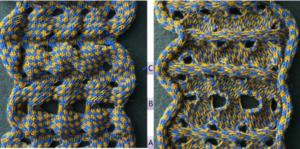 “Wisteria” meets hems
“Wisteria” meets hems  “Wisteria” cousin 2, also called fern leaf, hand technique
“Wisteria” cousin 2, also called fern leaf, hand technique 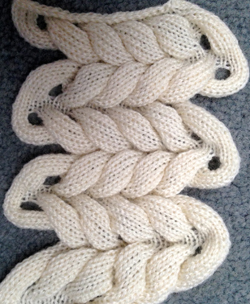 “Wisteria” cousin revisited (“holding” using slip stitch), the first programmed repeat, drawn on mylar. The 910 knit the image as drawn on the purl side, with no mirroring necessary
“Wisteria” cousin revisited (“holding” using slip stitch), the first programmed repeat, drawn on mylar. The 910 knit the image as drawn on the purl side, with no mirroring necessary 

“Wisteria” 2 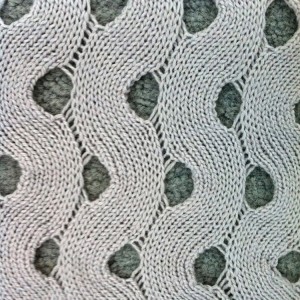 Horizontal “cable”
Horizontal “cable” 